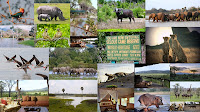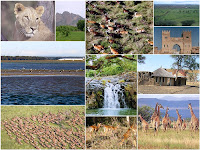Safari Notes: Selous Game Reserve, Tanzania
 |
| Spectacular Selous Game Reserve |
Selous: a remote, vast, absolutely wild and unspoiled wilderness is not easy to access. Traveling by road from the city of Dar es Salaam, via Kibiti to Mloka and the Selous Mbega Main Camp on the Rufiji River - takes 6 to 8 hour. Or from Morogoro to Kisaki and the Selous Mbega Camp, Kisaki Annex - will take you 4 to 5 hours. Or from Dar es Salaam via DSM Airport and Kisarawe to the Selous Mbega, Main Camp on the Rufiji River, but this can be very difficult when wet, and not many vehicles use this route. No route should be attempted without a 4WD vehicle. Or take the 5 to 6 hour trip by train from Dar es Salaam TAZARA (Tanzania Zambia Railroad) station, to the Kisaki station near the Selous Game Reserve where you can arrange to be picked up by a vehicle from the Selous Mbega Camp, Kisaki Annex. Or take the less than an hour daily scheduled flights from Dar es Salaam or Zanzibar to the Selous Game Reserve; or use the more expensive charter flight from Dar es Salaam to Mtemere or Matmbwe airstrips which serve Selous. As roads are not easily accessible during the rainy season and the train ride is rather tedious, it is preferable to take a chartered flight if you can afford it (you can easily get flights but you have to arrange and book early). Note: there are special offers for backpackers with local bus services.
The best time to visit the reserve is during the dry season(June to November), as there is a much better opportunity of spotting more and a wider range of animals during this period. The reserve is very rarely crowded and is a habitat for some of the greatest concentrations of wildlife on the continent, including tens of thousands of elephants,cape buffaloes, black rhinos, giraffes, African hunting dogs, several big cats and over half a million antelopes including sable, kudu, eland, hartebeest and Nyassa wildebeest; and you can easily see cheetahs here. Hundreds of different species of birds and thousands of plant species (one of the largest faunal reserves in the world) inhabit its diverse and striking landscape.The largest river in Tanzania, the Rufiji, runs through the reserve and it is through this mighty river that you can take a boat safari and see hippos, crocodiles and the many birds along the river. A wide array of accommodation is available in Selous, ranging from budget tented camps to very expensive, super luxury lodges and camps.
Due to it being protected by UNESCO, Selous has retained most of its wilderness, but it won't be long before all that, very sadly, change. Poaching, of elephants in particular, has intensified in the reserve in the last few years, and there is talk of some mining to start in the south; that will be no good for one of the greatest game wonders of the world. The reserve has also been able to maintain its uniqueness and remain unscathed due to the way it is managed: nine tenths of it, south of the Rufiji River, are set aside for hunting - leased out as private concessions where rich Russians, Americans, Arabs, Europeans. Japanese, Chinese and others come and pay hefty prices to shoot big game - this means that very few people ever set foot on this 90% of the reserve; and in the south, one tenth is set aside for photographic safaris - this is where most people go to.
The reserves landscape varies from rolling grassy woodlands and plains, to rocky outcrops intersected by the Rufiji River - the lifeblood of the reserve, whose tributaries form a network of lakes, lagoons and channels. There are even volcanic hot springs in some places. The Rufiji, by boat, offers a superb method of game viewing especially during the dry season when animals congregate. Very, very few tourists (the very lucky ones) get to see this scenic, extraordinary and spectacular part of Tanzania - the Selous; in fact - due to the remoteness of Selous and the expenses required, very, very few tourists can afford to come here. If you are fit and don't mind the discomfort, you can go to the reserve by road or rail, and then stay at one of the tented camps. Make sure to take and use drugs for malaria prophylaxis. To go to and experience the Selous Game Reserve, is a safari like no other and is comparable to no wildlife seeing adventure you have ever taken.
+ Tanzania Tourist Board
+ For more photos of Selous Game Reserve go to Flickr
+ Tanzania on Google Maps
+ Selous on Google Maps
+ More on Selous here, here and here
+ Wikitravel guide


